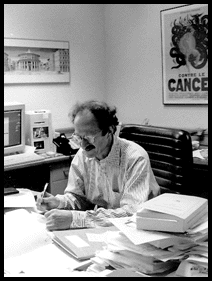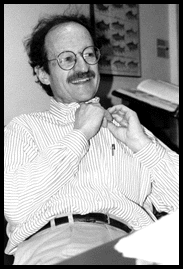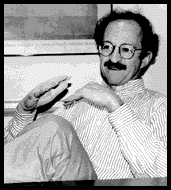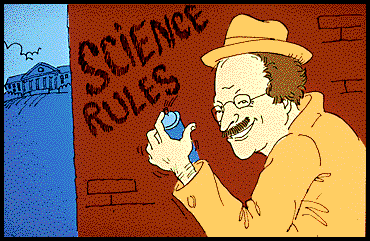BEYOND
POLITICS:
VARMUS SETS SIGHTS FOR
SELF AND SCIENCE
by Fran Pollner and Celia Hooper
Harold Varmus, the first Nobel laureate to serve as the director of NIH - and the first scientist-director of NIH to run his own research lab on campus - has had what he deems an "exhilarating" time of it thus far: not only has the pace of scientific discovery been accelerating during the three years he's been in Bethesda but he has managed to steer NIH clear of the fiscal icebergs that have cut into, if not capsized, other federal agencies.
And he expects no less during his remaining three years - his estimated time of departure.
In an interview with The NIH Catalyst, Varmus reflected on his accomplishments at what he designated the "middle of my term," citing among them changes in institute leadership and the ascendancy of the collaborative attitude. An eloquent advocate of basic research, he also took pride in the elevation of the status of clinical research confirmed in the blueprints for a new Clinical Research Center here.
 |
Q: With the 1996 elections now over, what are your plans for your "second
term" as NIH director?
Varmus: I see myself as unlinked to the electoral process. I don't believe the
NIH directorship should be as politicized as it's been the past eight years or so.
I didn't come in with the election - I came in some months later after it became
clear that Dr. Healy
and the administration were on divergent tracks - and my expectation
is that I'll probably leave the position before the second administration is over,
which would give the president a chance to name someone else who'd also [span] the
electoral events and would disconnect the NIH nomination process from the electoral
process.
Q: But you could decide to stay over.
Varmus: Well, it's subject to correction, but I think of myself as somewhere
near the middle of my term as director. I think the appropriate length of time here
is probably about six years. You can do a lot of things in six years, but beyond
that you probably start to get stale. It's good to have change in this job because
people bring in new ideas, new ways of doing things, and change is so healthy. It's
the nature of the scientific - and the educational - enterprise.
Q: Would you consider staying at NIH to continue doing research here?
Varmus: I'd consider that.
Q: What do you consider your accomplishments thus far, and what do you hope
to have accomplished by the time you leave?
Varmus: Several things have already been done. I see the changes in leadership
as achievements - and some of those institute directors and scientific directors
are likely to be in place considerably longer than I am. It's not only that I've
brought in specific strikingly accomplished and energetic people; it's also that
the way people think about the institutes is radically changed. There's a great deal
more interaction among the institutes, a greater sense that NIH is a single unit.
The leadership retreats we've had have helped people understand that although I'm
determined to ensure that the institute directors retain a good deal of autonomy,
it's also extremely important that the institutes work together in a way that both
expedites the science and improves our political and economic prospects.
The second achievement involves the clinical center and clinical research in general. There's no doubt that the new Clinical Research Center is going to be built and that it will have tremendous impact on life at NIH and on clinical research generally. In addition, I put together a very strong panel from the clinical research community, headed by David Nathan [president of the Dana Farber Cancer Institute in Boston], that made several recommendations about the way we train, recruit, finance, and otherwise provide an infrastructure for individuals doing clinical research. This is amazingly important as many of the basic sciences have matured to the point where clinical applications of laboratory discoveries are closer and closer to reality.
Some of the recommendations are already in place - for example, more loan-repayment programs. We've done that for clinical research here, and we're trying to extend that to investigators on the outside. Some of the training suggestions, too, have been put in place locally, and we'd like to see them in place more broadly. We're looking very carefully at recommendations regarding the GCRCs [General Clinical Research Centers].
[Another goal for NIH] is to achieve sufficient [budgetary] support so we at least keep ahead of inflation. We can no longer expect to get 10 and 20% increases, as sometimes occurred in the past. We're not going to be opening new institutes. Instead, what I'd like to see is steady growth and prompt attention to seizing new opportunities in science, identifying areas of emphasis, getting people to work together and share resources, and effectively interacting with the industrial sector, the private sector, making sure the money goes as far as possible.
We've had very good budgets in the past two years. Given the way the rest of the government fared, they were remarkable. I don't consider that a personal triumph so much as a triumph for the directors, who made extremely effective presentations; for the scientific community and other constituents of NIH, who were very strong advocates for our budget; for the remarkable leadership in Congress by John Porter [R-Ill.] and Mark Hatfield [R-Ore.] and many others; and for our supporters in the Department [of Health and Human Services], especially Donna Shalala, and in the White House. There are constraints, but we work as a team. If the institute directors continue as they have to advance the cause of NIH, we'll all rise with the incoming tide.

|
Varmus: Sure. There are some. Mark Hatfield is no longer in Congress. But I don't want to make predictions. We'll go forward with as strong a budget proposal from the president for FY 1998 as possible. We're in negotiations now with the White House, and we hope that Congress will act in our behalf with its usual bipartisan support.
Q: Have you learned anything in the time you've been here about dealing with
Congress and the White House that you might apply in the remaining three years?
Varmus: I'm not sure if "learning" is the right gerund, but I'm better
acquainted with a lot of people and have a good relationship with our Appropriations
Subcommittee chairmen, Congressman Porter and Senator Specter [Arlen Specter, R-Pa.].
Those relationships are important, so from that point of view, being around
for a while is a good thing. On the other hand, the longer you're here, the more
likely you are to have some major screw-up. I've been fairly lucky so far to have
avoided major potholes, and I think my credibility is pretty good. I'm not prone
to backslapping, but I think people respect my speaking frankly and and trying to
advance the cause of research and public health.
Q: What realms of science do you think most benefit from the collaborative
approach at NIH?
Varmus: I think they all do. Particularly dramatic, though, is an area like neuroscience,
where there's been a tradition of competition and a tendency for one institute to
claim a domain that is obviously a shared domain. So many institutes are involved
in neuroscience; so much is going on. Fundamental discoveries in genetics, various
aspects of cell growth, signaling molecules, and cell death have had profound effects
on every single disorder of the nervous system. Imaging devices have had an impact
on our perceptions of the nervous system.
Another important realm is the unravelling of the components of the genomes - in the plural, because the human genome is not the only important genome; this work is profoundly influencing every sphere of medical research. Genes become the glue to bind institutes together. We've seen institutes collaborate in the sense that matters most, that is, they've contributed money to a common pot to generate a center for the study of complex genetic traits, cooperatively run now in Baltimore [see story, "New Center to Tackle Disease"]. And everyone's paying attention to information as it arrives in GenBank, through the work of the Library of Medicine. It's a beehive.
Q: Do you see the Intramural Research Program undergoing any more major changes?
Varmus: There are still things we're thinking about, such as the need to pay
attention to how the intramural program is different from the extramural program.
Are there ways we can be more responsive to acute public health needs in such areas
as emerging infections, vaccine production, possibly some aspects of genetics? I
think it's incumbent upon us [to be more responsive] because of the different nature
of the activity here, the way it's financed, and the mass of scientists we have on
hand. One way is to make greater use of the Clinical Center in training students.
Michael
[Gottesman,
director of the Intramural Research Program] and I are pushing
hard to develop a program, in the next year, we hope, that will bring medical students
to the campus to learn clinical research, much the way the Howard Hughes Medical
Scholars program brings medical students here to do laboratory work. We hope to have
a significant cohort of students in that program next year. [See "From
the DDIR,".]
I've also been interested for a long time in developing a graduate program here. A Ph.D. program oriented around clinical problems is particularly appealing to me - not that one has to do clinical research to get a Ph.D., but every graduate student would have some time in the Clinical Center learning firsthand about some clinical problem. They could use that experience with disease as an informational backdrop and inspiration for doing high-quality laboratory research.
My advisory committee last week also suggested a program for people who had just gotten their Ph.D. to come here for one year before they go out as postdocs to do laboratory work. In that one year, they would get exposed to clinical problems. Another possibility would be to have Ph.D. students at other institutions around the country come to NIH for one year of exposure to clinical problems and then go back to [the home institution]. These are all worth thinking about, but the most fully developed of these ideas would be to have a Ph.D.-granting program in which the focus would be human physiology, with research programs built on intimate acquaintance with a clinical situation in the Clinical Center. The Clinical Center is a remarkable resource for teaching. Every time I go over there, I'm amazed at what nature has presented us.
Q: Would this cost a lot of money?
Varmus: Small potatoes compared with the overall budget of NIH. To set up a program
of fairly modest size to bring medical students to campus for exposure to clinical
research would not cost much money. But if we wanted, for example, to house these
students in a manner that resembles what is done for the Howard Hughes students staying
at the Cloisters, we might eventually have to build a dormitory, which would cost
a few million dollars. We might need to turn to the new National Foundation for Biomedical
Research (sometimes known as the Foundation for the NIH) to help raise money.

|
Varmus: NCI was in particularly difficult straits and clearly needed a very deep overhaul. The spectacular success there is due to [NCI Director] Rick Klausner's leadership and the willingness of people at NCI to pitch in and make very needed and important changes. Other institutes are undergoing reviews of their intramural programs. The NIMH review will be done in January; there are four others going on [NIAMS, NIA, NIDA, and NIAAA]; and there will be additional ones later. I don't expect changes as dramatic as those at the cancer institute, but I do expect significant differences in research emphases and changes in program content and the way the programs interface with extramural activities.
There's another type of review going on that people may not know about yet: I'm assembling small groups to provide independent advice to institute directors about their performance. I was surprised when I realized that institute directors can serve for a very, very long time without getting an independent review. Institute directors are unlikely to be criticized by their grantees due to the risk of reprisal. In general, we hesitate to criticize the person who is in charge of the treasury. But we all need corrective advice. I try to get it at least once a year by asking Tony Fauci [NIAID director] to run a principals-only, closed meeting of institute directors to elicit their frank opinions and come back to me with a list of the comments made - with no attribution. One of the dangers of my position is that the only person above me whom I see regularly is Donna Shalala [HHS secretary], but she doesn't know [day in and day out] what I do.
Q: Does it work?
Varmus: It's been useful. Yes. Happily, I have not received a lot of devastating
criticism, but I have gotten a few useful suggestions.
Q: Can you give us any examples?
Varmus: No. The advice was given in confidence, and I think I'll just keep it
confidential.
Q: Who will constitute the groups that will be giving advice to the institute directors?
Varmus: I make the final selections, but I get advice from several people,
including the institute directors themselves. Each institute has advocates, scientists,
patients, and people in Congress interested in how they manage, how they lead, how
they make scientific decisions. Institute directors have a harder job than I do,
and they're accountable to a lot of people. My objective here is to get an informal
report on where the directors have been successful and where corrective action ought
to be taken. The intention is certainly not to decide who gets another number of
years of service, but to make suggestions that will be received in the spirit in
which they are given.
Q: Do you anticipate gene therapy research and AIDS research proceeding any differently
as a result of the reconstitution of the RAC [Recombinant DNA Advisory Committee]
and last year's report of the NIH AIDS Research Program Evaluation Task Force [chaired
by Arnold Levine, chairman of the Molecular Biology Department at Princeton University]?
Varmus: AIDS is closer to the surface right now and the issues are somewhat clearer.
We've had a massive review of the AIDS program and an incredibly valuable report.
We've moved quite quickly on a lot of fronts, increasing the amount of money on RO1
grants, putting together a prevention initiative, and, most importantly, seizing
what is clearly the most underexploited goal of the research endeavor: to develop
a vaccine. I'm quite optimistic that the leadership we're trying to provide in AIDS
vaccine development is going to have a very stimulatory effect on investigators everywhere
to think more seriously about the prospects of a vaccine, about doing more work in
immunology. I have had the good fortune to be able to recruit, with the assistance
of the institute directors and Bill
Paul [director, Office of AIDS Research], one
of the world's great scientists - David Baltimore [professor of molecular biology
and immunology at the Massachusetts Institute of Technology] - to chair the AIDS
Vaccine Research Committee.
We're also all very much inspired by the discovery of the coreceptors [for HIV], actually a series of discoveries catalyzed by the fundamental discovery made in the intramural program by Ed Berger [NIAID] and colleagues, which really set this whole new field moving. This is one of those examples where a dramatic scientific discovery fertilizes a scientific field so that a whole crop of new investigators seems to have grown up instantly. And there's a lot to exploit in terms of treatment and prevention.
 |
Varmus: There have been a lot of high points. I get a thrill when a major discovery is announced; I've been exhilarated by our budgetary success.
As for the lows, we're very frustrated by our difficulties in human embryo research. Mistakes were made in the very beginning in the way this work was described to the public and Congress - partly my fault, partly not - and I've been frustrated by the real difficulty in moving this very important new field of work ahead. This includes new contraceptive methods, understanding fertilization well enough to improve in vitro fertilization procedures, prospects for developing human embryonic stem cells that could have a tremendous role in transplantation in the future.
Q: Do you see any way to counter misapprehensions about this research?
Varmus: It's going to be hard. I don't want to lay out a strategy at this
point, but I hope that public education . . . will allow us to get there eventually.
Q: What about your own research? Do you like being an intramural researcher?
Varmus: I think it's going reasonably well. I try to get to my lab every day.
And, yes, I enjoy it. I don't want to extrapolate [about the experience of typical
scientists at NIH] from what's obviously an unusual situation. While I try not to
take advantage of my position, I think inevitably it's going to help me out. Obviously,
people are not going to place obstacles in my way, and I probably get minor renovations
more quickly than others do. So I don't think I always get a totally fair view of
what's going on. But having a lab certainly has acquainted me with the difficulties
in parking, which I hear about every day. I'm worried about that, and I'm working
hard to try to develop a parking plan that will solve this problem.
I also hear about the difficulty in working in locked labs [due to strict radiation security rules imposed last year]. . . . I never carry keys around. I hate it when I can't get into my own lab because the doors have to be locked because there's a low-level radioactive filter on a bench top. Having a lab puts me in touch with some of these realities.
I've also very much enjoyed my collaborations on campus. I've had the good fortune to tap into a lot of the richness of the intramural research program. It's been wonderful.
Q: Is it hard to balance your lab and administrative activities?
Varmus: Well, let's face facts. I don't spend as much time in the lab as I
wish I did. I don't spend as much time reading the journals as I wish I did. But
I do try to make it [to the lab] every day and hold long lab meetings once a week.
I'm accessible to my group, I come in occasionally on Saturdays or Sundays or stay
late in the day during the week. We do get a measure of productivity in papers published,
and I don't think the rate is so different from what it was in San Francisco [University
of California at San Francisco]. I have a much smaller lab, but I'm fortunate to
have postdoctoral fellows who are independent and bright, and we do quite well. In
addition, I'm very lucky to have Suzanne
Ortiz, who managed my lab in San Francisco
and who shields me from some of the administrative problems.
Q: Is there anything else youid like to say to The Catalyst's readers?
Varmus: You tell me. What are people worried about?
Q: Postdocs are worried about getting jobs. . . .
Varmus: Well, everyone in the world is worried about getting jobs. There's
a shortage of jobs. But there are jobs, and everybody I've seen look for one has
always ended up getting something, maybe in the industrial sector rather than in
academia and not always laboratory positions, but people do find jobs. There are
many reasons to be optimistic about maintaining a career in which one's training
has been in the biological sciences. But I think NIH investigators have got to become
better mentors; we need to know our trainees well and to provide a realistic sense
of where the jobs are and what each trainee is best suited to do.
